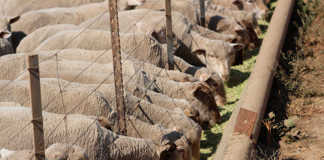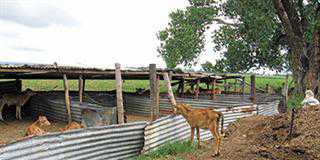The blue tick gets its name from the blue tinge to the body and yellow legs, although may also take on a darker tinge (as seen in this somewhat ‘dehydrated’ one). halus (formerly Boophilus) microplus (cattle tick)

The cattle tick is oval in shape and colouration varies from reddish brown to flesh-colured. The female is on the right.
(Photo: Alan Walker)
The cattle tick (Rhipicephalus microplus) adapts quickly to areas where it has been ‘introduced’. Larvae gather on the soft skin of an animal, such as the inner thighs, flanks, forelegs and abdomen.
Habitat: Savannah; wooded grassland.
Hosts: Primarily cattle, though it will also utilise horses, donkeys, sheep, pigs and occasionally sheep and buffalo.
Diseases: Asiatic redwater, bovine babesiosis and anaplasmosis (Anaplasma marginale) gall fever. The animal shows reduced weight, and a decrease in milk yield.
Control: R. microplus can build up acaricide resistance more rapidly than most other tick species, so avoid prolonged treatment with a single acaricide. If there is resistance to both organophosphate and chlorinated hydrocarbon acaricides, carbamate acaricide can be effective. Another option is regular dipping until the livestock are tick-free. After two more dips, send the animals to a tick-free pasture. The pasture they were removed from must lie idle for six to 10 months. The novel cattle tick vaccine can be used as an alternative to dipping.
Amblomma hebraeum (Bont tick)

A male bont tick. Males reach a length of 6mm, while females can be 5mm long. Both sexes have large, powerful mouthparts capable of causing considerable damage to the host. (Photo: Paul Donavan)
Bont (Afrikaans for ‘colourful’) ticks are typically found in short pasture. They collect on the lower legs of animals, or between their hooves, and crawl from there to their chosen feeding site, usually around the hairless regions of the body such as the genitalia and underbelly.
Habitat: The egret is one of the tick’s main hosts; this makes it the most widely distributed tick on the continent. It has been recorded in at least 30 countries, including South Africa, Namibia, Botswana, Zimbabwe, Malawi, Mozambique and Angola.
Hosts: Cattle, goats, sheep, horses and dogs, as well as antelope and birds are all targeted by the bont tick.
Diseases: One of the main diseases spread by the tick is heartwater (Ehrlichia ruminantium), where fluid develops around the heart and lungs. Mortalities can be as high as 80% in infected animals. An additional problem is potential blood loss. Before dropping off to lay its eggs, a female can consume up to 20ml of blood.
A heavy infestation can lead to weight loss, reduced appetite and a predisposition to other diseases. Signs include nervousness (more obvious in cattle than sheep or goats), difficulty in walking, respiratory distress, convulsions and death.
Control: Control can include movement restrictions, pre-export inspection, quarantine and treatment with acaricides while the tick is on the host animal. It has been suggested that livestock should not be reintroduced into pasture where measures have been in place to eradicate the tick for at least four years. A heartwater vaccine is available, and animals respond well to treatment with tetracycline.
Rhipicephalus (Boophilus) decoloratus (Blue tick)

The blue tick gets its name from the blue tinge to the body and yellow legs, although may also take on a darker tinge (as seen in this somewhat ‘dehydrated’ one). (Photo: paul Donavan)
The blue tick is present throughout the year, but is most active in December to January and March to July. It can be widely dispersed on the host, although the adults prefer flanks and underbelly, while the immatures are found mostly on the ears, neck and dewlap.
Habitat: Savannah; grasslands; wooded areas.
Host: Primarily cattle and equines, but sheep, goats, gemsbok and dogs have also been identified as carriers.
Diseases:Redwater disease, gallsickness, babesiosis, anaplasmosis, anaemia, and cattle tick ‘worry’. Heavily infected livestock may lose weight and show significant reduction in milk yield. Babesiosis manifests as a rise in body temperature, red urine, emaciation and death.
Control: A three-weekly dipping cycle with acaricide. During winter, dipping may be reduced due to lower lick levels. Beware of resistance, however. A cost-effective alternative that is friendlier to both animals and the environment, is to immunise livestock with Rhipicephalus microplus Bm86 protective antigen.
Produced in the 1990s, Bm86 is effective in controlling a number of tick species of the genus Rhipicephalus. Vaccination has a number of benefits: reducing the number of engorged ticks on the animal as well as the number of larvae on the animal over successive generations may disrupt the tick’s breeding cycle. Females are likely to drop off before they are ready to breed. In addition, it reduces the chances of resistance build-up.














